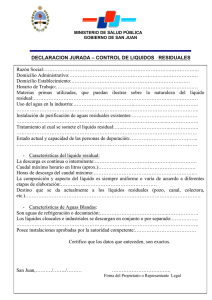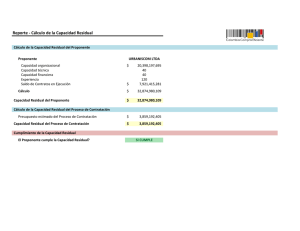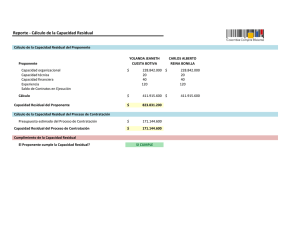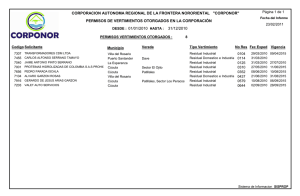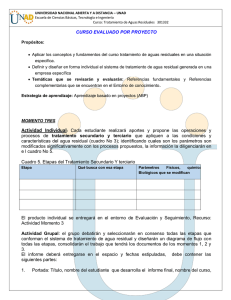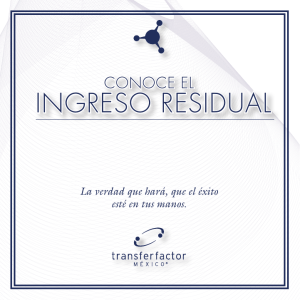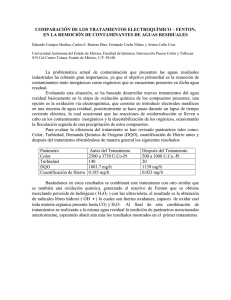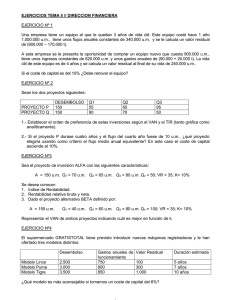Pag. 36 Reporte de Caso / Case Report LITIASIS RESIDUAL
Anuncio
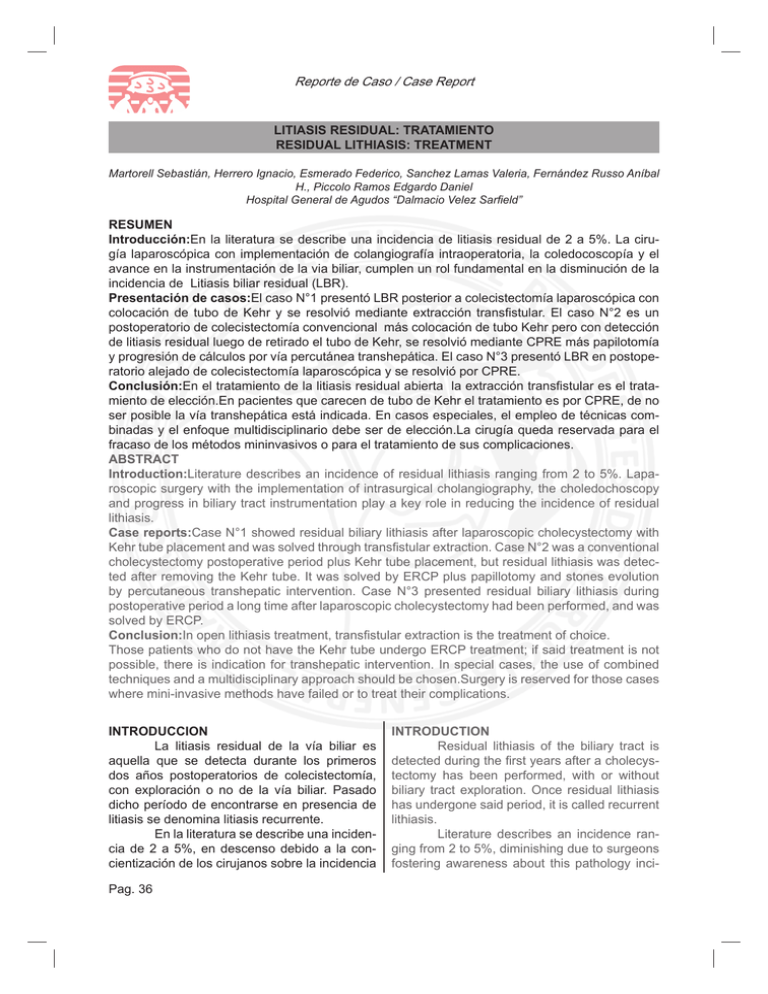
Reporte de Caso / Case Report LITIASIS RESIDUAL: TRATAMIENTO RESIDUAL LITHIASIS: TREATMENT Martorell Sebastián, Herrero Ignacio, Esmerado Federico, Sanchez Lamas Valeria, Fernández Russo Aníbal H., Piccolo Ramos Edgardo Daniel Hospital General de Agudos “Dalmacio Velez Sarfield” RESUMEN Introducción:En la literatura se describe una incidencia de litiasis residual de 2 a 5%. La cirugía laparoscópica con implementación de colangiografía intraoperatoria, la coledocoscopía y el avance en la instrumentación de la via biliar, cumplen un rol fundamental en la disminución de la incidencia de Litiasis biliar residual (LBR). Presentación de casos:El caso N°1 presentó LBR posterior a colecistectomía laparoscópica con colocación de tubo de Kehr y se resolvió mediante extracción transfistular. El caso N°2 es un postoperatorio de colecistectomía convencional más colocación de tubo Kehr pero con detección de litiasis residual luego de retirado el tubo de Kehr, se resolvió mediante CPRE más papilotomía y progresión de cálculos por vía percutánea transhepática. El caso N°3 presentó LBR en postoperatorio alejado de colecistectomía laparoscópica y se resolvió por CPRE. Conclusión:En el tratamiento de la litiasis residual abierta la extracción transfistular es el tratamiento de elección.En pacientes que carecen de tubo de Kehr el tratamiento es por CPRE, de no ser posible la vía transhepática está indicada. En casos especiales, el empleo de técnicas combinadas y el enfoque multidisciplinario debe ser de elección.La cirugía queda reservada para el fracaso de los métodos mininvasivos o para el tratamiento de sus complicaciones. ABSTRACT Introduction:Literature describes an incidence of residual lithiasis ranging from 2 to 5%. Laparoscopic surgery with the implementation of intrasurgical cholangiography, the choledochoscopy and progress in biliary tract instrumentation play a key role in reducing the incidence of residual lithiasis. Case reports:Case N°1 showed residual biliary lithiasis after laparoscopic cholecystectomy with Kehr tube placement and was solved through transfistular extraction. Case N°2 was a conventional cholecystectomy postoperative period plus Kehr tube placement, but residual lithiasis was detected after removing the Kehr tube. It was solved by ERCP plus papillotomy and stones evolution by percutaneous transhepatic intervention. Case N°3 presented residual biliary lithiasis during postoperative period a long time after laparoscopic cholecystectomy had been performed, and was solved by ERCP. Conclusion:In open lithiasis treatment, transfistular extraction is the treatment of choice. Those patients who do not have the Kehr tube undergo ERCP treatment; if said treatment is not possible, there is indication for transhepatic intervention. In special cases, the use of combined techniques and a multidisciplinary approach should be chosen.Surgery is reserved for those cases where mini-invasive methods have failed or to treat their complications. INTRODUCCION La litiasis residual de la vía biliar es aquella que se detecta durante los primeros dos años postoperatorios de colecistectomía, con exploración o no de la vía biliar. Pasado dicho período de encontrarse en presencia de litiasis se denomina litiasis recurrente. En la literatura se describe una incidencia de 2 a 5%, en descenso debido a la concientización de los cirujanos sobre la incidencia Pag. 36 INTRODUCTION Residual lithiasis of the biliary tract is detected during the first years after a cholecystectomy has been performed, with or without biliary tract exploration. Once residual lithiasis has undergone said period, it is called recurrent lithiasis. Literature describes an incidence ranging from 2 to 5%, diminishing due to surgeons fostering awareness about this pathology inci- de esta patología y la disponibilidad creciente de métodos que favorecen la prevención de la misma. Dicha prevención inicia en el preoperatorio con un interrogatorio completo en busca de sintomatología canalicular, la correcta valoración de la ecografía hepatobiliopancreatica, la selección de pacientes que requieran realizar una Colangioresonancia y frente al diagnóstico de litiasis coledociana la posibilidad de realizar una Colangiopancreatografía Retrograda Endoscópica (CPRE) preoperatoria. El advenimiento de la cirugía laparoscópica con la implementación de la colangiografía intraoperatoria (pudiendo realizarse en forma sistemática o selectiva de acuerdo a los protocolos de cada institución), la coledocoscopía y el avance en la instrumentación de la vía biliar, cumple un rol fundamental en la disminución de la incidencia de LBR. La litiasis residual puede presentarse en dos situaciones: - La litiasis residual abierta (o inmediata) se presenta en pacientes con via biliar drenada. Se diagnostica mediante colangiografía transkehr. - La litiasis residual cerrada (o mediata) se presenta en pacientes sin drenaje de la vía biliar. Se diagnostica mediante Colangioresonancia o CPRE PRESENTACION DE CASO CASO CLINICO N°1. Litiasis residual con extracción transkehr. Paciente de 23 años que consulta por cólico biliar asociado a nauseas y equivalentes febriles sin síntomas compatibles con patología canalicular, con antecedente de pancreatitis en el mes previo. Como datos positivos de laboratorio presentaba GOT 276 UI/L, GPT 238 UI/L, FAL 167 UI/L, Bilirrubina total 1.1mg/dl, Bilirrubina directa 0.8 mg/dl, Amilasa 110 UI/L. En la ecografía se observa vesícula multilitiásica, colédoco de 10mm con dos litos de 8 y 9 mm en su porción intrapancreática. Se realiza RMN que informa panlitiasis. No se puede realizar CPRE acorde al protocolo del servicio debido a la falta de disponibilidad de turnos a corto plazo dentro del sistema municipal. Se realiza colecistectomía laparoscópica con instrumentación de la vía biliar, se extraen múl- dence and the growing availability of methods favoring its prevention. Said prevention starts in the preoperative stage, with a complete interview seeking canalicular symptomatology, the appropriate assessment of hepatobiliar-pancreatic ultrasound, the selection of patients requiring a magnetic cholangioresonance and, upon being diagnosed choledocholithiasis, the possibility of performing a preoperative Endoscopic Retrograde Cholangiopancreatography (ERCP). The advent of laparoscopic surgery with the implementation of intrasurgical colangiography (which can be performed in a systematic or selective way according to each institution’s protocols), the choledochoscopy and progress in biliary tract instrumentation, play a fundamental key in reducing the incidence of residual lithiasis. Residual lithiasis may be found in two situations: - Open residual lithiasis (or immediate) may be found in patients with drained biliary tract. It is diagnosed performing a transkehr cholangiography. - Closed residual lithiasis (or mid- to long-term) is found in patients with no biliary tract drainage. It is diagnosed by means of magnetic cholangioresonance or ERCP CASE REPORTS CLINICAL CASE N°1. Residual lithiasis with transkehr extraction. A 23-year-old patient presented with biliary colic associated with nausea and febrile equivalents without symptoms compatible with canalicular pathology, and with a pancreatitis history from the previous month. The patient showed the following positive laboratory results GOT 276 UI/L, GPT 238 UI/L, TAP 167 UI/L, total bilirubin 1.1mg/dl, direct bilirubin 0.8 mg/dl, amylase 0 UI/L. The ultrasound showed multilithiasic gallbladder, 10mm bile duct with two stones of 8 and 9 mm respectively in its intrapancreatic portion. A NMR was performed and reported panlithiasis. The performance of an ERCP was not possible according to the service protocol due to the lack of short-term shifts availability within the municipal system. A laparoscopic cholecystectomy with biliary tract instrumentation was carried out; multiple stones Pag. 37 Reporte de Caso Rev. Arg. Res. Cir 2013; 18(2):36 -41. Reporte de Caso / Case Report tiples litos de la vía biliar principal por vía transcística inicialmente y luego por coledocotomía. Se coloca tubo de Kehr. Se comprueba mediante colangiografia intraoperatoria ausencia de imágenes de defecto de relleno y buen pasaje de la sustancia de contraste al duodeno. La paciente evoluciona favorablemente y se externa. En la colangiografía transkehr de control se detecta la presencia de litiasis residual. Se realiza extracción transfistular con controles posteriores satisfactorios. Permanece sin intercurrencias a la fecha. CASOS CLINICO N°2. Litiasis residual con extracción percutánea transhepática. Paciente femenino de 46 años de edad con antecedente de pancreatitis aguda biliar leve y diagnóstico de litiasis coledociana por Colangioresonancia. Se realiza colecistectomía convencional con instrumentación de vía biliar y colangiografia intraoperatoria transkehr en la que se describe vía biliar dilatada, expedita y con buen pasaje a duodeno. En postoperatorio alejado, habiendo sido retirado el tubo de Kehr luego de los controles pertinentes, se identifica por Colangioresonancia presencia de litiasis residual. Se realiza papiloplastía y progresión de cálculos por vía percutánea. Intercurre con un episodio de pancreatitis aguda post procedimiento, desarrolla un absceso retroperitoneal que se resuelve con laparotomía exploratoria y drenaje. Permanece sin más complicaciones a la fecha. CASO CLINICO N°3. Litiasis residual con resolución por CPRE. Paciente femenino de 57 años con antecedente de cólicos vesiculares de 2 años de evolución. Laboratorio sin datos positivos y ecografía que informa: vesícula forma clásica, contenido litiásico múltiple, paredes lisas y delgadas. Vías biliares no dilatadas. Se realiza colecistectomía laparoscópica por litiasis vesicular el 09/12. Cursa un postoperatorio sin particularidades hasta el 1/2013 cuando consulta por presentar ictericia, coluria y acolia de 5 días de evolución. Refiere prurito agregado en las últimas 48 hs. Niega dolor abdominal. Laboratorio con GB 6200 /mm3, GOT 165 UI/L, GPT 138 Pag. 38 were removed from the main biliary tract, initially, in a transcistic way and then through choledochotomy. A Kehr tube was inserted. With an intrasurgical cholangiography, the absence of filling defect images and the good passage of contrast medium into the duodenum were verified. The patient’s progress was favorable and was discharged. In the control transkehr cholangiography, the presence of residual lithiasis was detected. A transfistular extraction was performed and follow-up controls were satisfactory. No intercurrent disease has been noted up to date. CLINICAL CASE N°2. Residual lithiasis with percutaneous transhepatic removal. 46-year-old female patient with history of mild biliary acute pancreatitis and choledocholithiasis diagnosis obtained by magnetic cholangioresonance. A conventional cholecystectomy with biliary tract instrumentation and transkehr intrasurgical cholangiography were performed; a dilated, clear biliary tract with good passage of contrast medium into duodenum was described. In the late postoperative period, after having removed the Kehr tube following the appropriate controls, the presence of residual lithiasis was detected at magnetic cholangioresonance. A papilloplasty and progression of gallstones through percutaneous approach were performed. An intercurrent post-procedure acute pancreatitis episode was detected; a retroperitoneal abscess developed and was solved with exploratory laparotomy and drainage. No further complications have been detected up to date. CLINICAL CASE N°3. Residual lithiasis with resolution by ERCP. 57-year-old female patient with a 2-year history of gallbladder colics. No positive data from laboratory were obtained and ultrasound reported as follows: normal-shaped gallbladder, with multiple lithiasic content, smooth and thin walls. Non-dilated biliary tracts. Laparoscopic cholecystectomy due to gallbladder lithiasis was performed on 12/09. The postoperative period remained UI/L, FAL 287UI/L, Bilirrubina Total 14.5 mg/dl, Bilirrubina Directa 8.7mg/dl, AMILASA 41 UI/L. En la ecografía se observa dilatación del Colédoco (11,9 mm). Se realiza Colangioresonancia que informa dilatación de la vía biliar intra y extrahepática, colédoco de 16 mm con imagen de defecto de relleno de 4mm en colédoco intrapancreático. Páncreas sin particularidades. Se realiza CPRE con papilotomía y extracción de cálculo de 10 mm con canastilla. La paciente evoluciona favorablemente permaneciendo asintomática y con controles de laboratorio normales a la fecha. DISCUCIÓN A lo largo de la historia se han desarrollado distintas estrategias para el tratamiento de la litiasis residual. Muchas de ellas con resultados terapéuticos muy alentadores y que siguen vigentes a la fecha. El desafío actual es la articulación de las mismas y la adecuada selección de procedimiento para cada paciente. TRANSFISTULAR La primera extracción con pinzas bajo control radioscópico en el mundo la realiza el Dr. Vaccarezza (1944). En 1966 publica su trabajo el Dr. Mazzariello, precursor mundial del tratamiento mininvasivo de litiasis residual a través de trayectos fistulosos. En 1969, Lagrave implementa la canastilla metálica y Burhenne en 1972 utiliza sondas con guías y catéteres para la extracción de litiasis de vía biliar. El procedimiento se realiza cuatro semanas después de la cirugía, para permitir un trayecto fistuloso revestido de tejido fibroso. Consiste en la extracción del tubo de Kehr y acceder a la vía biliar utilizando el trayecto fistuloso. El éxito del procedimiento es del 95%. CPRE En 1968 McCune reporta la primera Pancreatografía Retrógrada Endoscópica (PRE) al insertar un catéter en la ampolla de Vater bajo visión endoscópica, utilizando un fibroendoscopio y opacificando la vía pancreática, por lo que se considera pionero de la CPRE. En 1973 se realizo la primera CPRE con esfinterotomía. La CPRE con esfinterotomía y esfinteroplastía modificó la conducta terapéutica en la litiasis coledociana y litiasis residual, alcanzan- unremarkable up to January, 2013, when she consulted due to a history of jaundice, choluria and acholia of 5 days evolution. She referred aggregate pruritus in the last 48 hs. She denied abdominal pain. Laboratory results were GB 6200 /mm3, GOT 165 UI/L, GPT 138 UI/L, TAP 287UI/L, total bilirubin 14.5 mg/dl, direct bilirubin 8.7mg/dl, AMYLASE 41 UI/L. The ultrasound showed bile duct dilation (11.9 mm). A magnetic cholangioresonance was performed and its results were intra and extrahepatic biliary duct dilation, 16 mm bile duct with 4mm filling defect image in intrapancreatic bile duct. Pancreas was unremarkable. EPCR with papillotomy and 10 mm gallstone removal were performed with basket. The patient’s evolution is favorable and remains asymptomatic and with normal laboratory controls up to the present. DISCUSSION Several strategies have been developed to treat residual lithiasis throughout history. Many of them have had really encouraging therapeutic results which are current up to date. The present challenge is the coordination of said strategies and the appropriate selection of the procedure to be followed with each patient. TRANSFISTULAR APPROACH The first removal using pliers under radioscopic control in the world was performed by Dr Vaccarezza (1944). In 1966, Dr Mazzariello published his work, a worldwide pioneer in miniinvasive treatment of residual lithiasis by means of fistulous tracts. In 1969, Lagrave implemented the metallic basket and Burhenne, in 1972 used probes with guides and catheters to remove lithiasis of the biliary tract. The procedure is carried out four weeks after surgery, in order to allow a fistulous tract covered in fibrous tissue. It consists in removing the Kehr tube and accessing the biliary tract using the fistulous tract. The procedure success rate is of 95%. ERCP In 1968, McCune reported the first Endoscopic Retrograde Cholangiopancreatography (ERCP) upon inserting a catheter into Vater’s ampulla under endoscopic vision, using a fibroendoscope and resulting in the pancreatic tract opacification; therefore, he is considered an ERCP pioneer. In 1973, the first ERCP Pag. 39 Reporte de Caso Rev. Arg. Res. Cir 2013; 18(2):36 -41. Reporte de Caso / Case Report do en la actualidad un éxito terapéutico en un 90 a 96%. Cerca del 10% de los pacientes sometidos al tratamiento endoscópico pueden desarrollar algún tipo de complicación, con una mortalidad promedio de 1%. Las complicaciones mayores inmediatas son: - Hemorragia: complicación más frecuente, ocurre en un 2,5 a 4% de los casos. Relacionada con el tamaño de incisión de la papilotomía. Habitualmente cede en forma espontanea o mediante tratamiento endoscópico. - Pancreatitis: tiene una incidencia del 1 a 4%. Se debe diferenciar del aumento aislado de amilasa que se presenta en el 75% de los casos y no tiene repercusión clínica. - Perforación: el riesgo de perforación es menor al 1%, habitualmente es retroperitoneal, leve e inadvertida al momento del estudio. - Colangitis: Incidencia de 1 a 3%. Se relaciona habitualmente con una evacuación litiasica incompleta de pospapilotomía asociada a un mal drenaje biliar. TRANSHEPATICO La primer colangiografía transhepática fue desarrollada en 1937 y el drenaje biliar transhepático como drenaje externo en el año 1952 por Leger. El procedimiento posee una efectividad superior al 90% y baja tasa de complicaciones. La complicación más frecuente es la hemorragia (16%), aunque solo en el 3% requiere de transfusiones. En menor medida se describen casos de pancreatitis (3,4%), bilioma y abscesos hepáticos. CIRUGÍA CONVENCIONAL O LAPAROSCOPICA En 1925 Bakes desarrollo la coledocoscopia con espejos y los dilatadores de la ampolla de Vater. Pablo Mirizzi inició el uso de la colangiografía intraoperatoria en 1931. Melver introdujo la coledocoscopia en 1941 y en 1965 Lippman desarrollo el coledocoscopio flexible. RENDEZ VOUS. Tratamiento combinado percutáneos endoscópicos Es un término francés que significa encuentro. En casos especiales, el empleo de técnicas combinadas debe ser de elección; por ello, este tipo de pacientes deben evaluarse y tratarse Pag. 40 with sphincterotomy was carried out. ERCP with sphincterotomy and sphincteroplasty modified the therapeutic approach of lithiasis and residual lithiasis, reaching a therapeutic success rate of 90 to 96% at present. Around 10% of patients undergoing endoscopic treatment may develop some kind of complication, with an average mortality of 1%. Major immediate complications are as follows: - Hemorrhage: the most frequent complication; it occurs in 2.5 to 4% of cases. It is related to the papillotomy incision size. Usually it lessens spontaneously or with endoscopic treatment. - Pancreatitis: its incidence is 1 to 4%. It should be differentiated from the isolated amylase increase which presents in 75% of cases and does not have a clinical impact. - Perforation: the risk of perforation is lower than 1%; generally, it is retroperitoneal, mild and unnoticed during the study period. - Cholangitis: Incidence of 1 to 3%. Usually, it is related to a post-papillotomy incomplete lithiasic emptying of associated with bad biliary drainage. TRANSHEPATIC APPROACH The first transhepatic cholangiography was developed in 1937 and the transhepatic biliary drainage as an external drainage, in 1952 by Leger. The procedure efficacy rate is higher than 90% and its complication rate is low. Hemorrhage (16%) is the most frequent complication, though it only requires transfusions in 3% of cases. Cases of pancreatitis (3.4%), biloma and hepatic abscesses are less frequently reported. LAPAROSCOPIC OR CONVENTIONAL SURGERY In 1925, Bakes developed the choledochoscopy using a mirror and dilators of the ampulla of Vater. Pablo Mirizzi started the use of the intrasurgical cholangiography in 1931. Melver brought in the choledochoscopy in 1941 and, in 1965, Lippman developed the flexible choledochoscope. RENDEZ VOUS. Combined percutaneous endoscopic treatment It is a French term basically meaning to meet up. Rev. Arg. Res. Cir 2013; 18(2):36 -41. CONCLUSIÓN En el tratamiento de la litiasis residual abierta la extracción transfistular es el tratamiento de elección. Si el paciente carece de tubo de Kehr el tratamiento de elección es la CPRE. De no estar disponible o no resultar efectivo el tratamiento endoscópico, la vía percutánea transhepática está indicada. En casos especiales, el empleo de técnicas combinadas y el enfoque multidisciplinario debe ser de elección. La cirugía queda reservada para el fracaso de los métodos mininvasivos o para el tratamiento de sus complicaciones. In special cases, combined techniques must be chosen; therefore, this kind of patient should be assessed and treated by a team of surgeons, interventionists and biliary endoscopists. In case of RESIDUAL LITHIASIS WITHOUT FISTULOUS TRACT AND BILROTH II GASTRECTOMY, a transhepatic wire is inserted into the biliary tract passing through the papilla and the gastrectomy afferent loop up to the gastrojejunal anastomosis. There, the endoscopist holds it with a foreign body pliers and pulls percutaneously on the wire, dragging the endoscope until facing it with the papilla in order to perform the papillotomy and the endoscopic removal of lithiasis. In case of STUCK GALLSTONES, that cannot be endoscopically removed, with transhepatic percutaneous drainage the biliary tract is decompressed above the stone, which allows its clearance and endoscopic removal. CONCLUSION In open lithiasis treatment, transfistular extraction is the treatment of choice. Those patients who do not have the Kehr tube undergo ERCP treatment. If said treatment is not possible or does not result effective, there is indication for transhepatic percutaneous intervention. In special cases, the use of combined techniques and a multidisciplinary approach should be chosen. Surgery is reserved for those cases where mini-invasive methods have failed or to treat their complications. BIBLIOGRAFÍA 1 Anbok Lee, Seog Ki Min, Jae Jung Park, and Hyeon Kook Lee. Laparoscopic common bile duct exploration for elderly patients: as a first treatment strategy for common bile duct stones. J Korean Surg Soc. 2011 August; 81(2): 128–133. 2 Pekolj J. Litiasis residual de colédoco. PROACI (Quinto Módulo 2) 2002; 65-91. 3 Mazzariello R. Extracción de grandes cálculos por vía transparietohepática. Rev Arg Cir 1988; 56: 241. 4 Mariano Palermo, Mercedes Giménez Dixon, Fernando Álvarez, Adrián Ortega, Miguel Bruno, Francisco J Tarsitano. Abordaje transfistular para el tratamiento de la litiasis residual de la vía biliar. Acta Gastroenterol Latinoam 2010;40: 239-243. 5 M E Clouse, K R Stokes, R G Lee, K R Falchuk. Bile duct stones: percutaneous transhepatic removal. Radiology 1986; 160: 525-529. 6 Pekolj J, De Santibañez E, Sívori J, Ciardullo M, Campi O, et al. La colangiografía transcística durante la colecistectomía laparoscópica. Rev. Argent. Cirug. 1993; 64:5-11. 7 Morino M, Baracchi F, Miglietta C, Furlan N, Ragona R, Garbarini A. Preoperative endoscopio sphincterotomy versus laparoendoscopic rendezvous in patients with gallbladder and bile duct stones. Ann Surg 2006; 244: 889-893. 8 La Greca G, Barbagallo F, DiBlasi M, Di Stefano M, Castello G. Rendezvous technique versusendoscopio retrograde cholangiopancreatography to treat bile duct stones reduces endoscopio time and pancreatic damage. J Laparoendosc Adv Surg Tech 2007; 17: 167-171. 9 Drs. Marcelo Morán D., Manuel Segovia C., Víctor Vázques M., María Isabel Villena E., Raúl Novoa R., Roberto Salazar A. "Rendezvous" laparoendoscópico secuencial en colelitiasis con cálculos en colédoco. Rev. Chilena de Cirugía. Diciembre 2008; 60: 524-526. 10 Sánchez-Ismayel A, Rodriguez O, Sanchez R, Benitez G, Bellorín O, Paredes J. Coledocoscopia en la exloración laparoscópica de la via biliar para resolución de coledocolitiasis. Rev Venez Cirug 2007; 60: 177-182. Pag. 41 Reporte de Caso por un equipo de cirujanos, intervencionistas y endoscopistas biliares. En casos de LITIASIS RESIDUAL SIN TRAYECTO FISTULOSO Y GASTRECTOMÍA BILROTH II, se introduce un alambre transhepático en la via biliar que atraviesa la papila y avanza por el asa aferente de la gastrectomía hasta la anastomosis gastroyeyunal. En ese lugar el endoscopista lo toma con una pinza de cuerpo extraño y tira en forma percutánea del alambre arrastrando el endoscopia hasta enfrentarlo a la papila para realizar la papilotomia y excéresis endoscópica de la litiasis. En casos de CÁLCULOS ATASCADOS, que no pueden retirarse en forma endoscópica, con un drenaje percutaneo transhepática se descomprime la vía biliar por encima del lito, lo que permite su desobstrucción y su extracción endoscópica.
